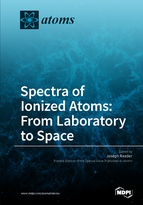Spectra of Ionized Atoms: From Laboratory to Space
A special issue of Atoms (ISSN 2218-2004). This special issue belongs to the section "Atomic, Molecular and Nuclear Spectroscopy and Collisions".
Deadline for manuscript submissions: closed (30 July 2017) | Viewed by 71142
Special Issue Editor
Special Issue Information
Dear Colleagues,
The spectra of ionized atoms continue to play an important role in understanding a wide variety of plasmas. The relatively new discipline of Laser-Induced Breakdown Spectroscopy (LIBS) is being used on Earth to produce lower ionization stages of atoms for diagnostics of solid samples, and also in space to determine contents of rocks on Mars and Venus. Spectra of lower stages of ionization are also found in space in nebulae, interstellar clouds, chemically peculiar stars, and in the sun. There is a continuing need for the wavelengths, energy levels, and oscillator strengths. For higher ionization stages, data are needed for spectra found in the hot plasmas of tokamaks and other machines aimed at developing new energy sources. Since much of the data for these hot plasmas must come from ab initio calculations, laboratory experiments can serve to evaluate the accuracy of the calculations. Experiments with electron beam ion traps (EBITs) can remove all but a few remaining electrons and thus form a basis for evaluating calculations of ions having only a few electrons. This Special Issue of Atoms will highlight the need for continuing research on the spectra of all types of ionized atoms.
Dr. Joseph Reader
Guest Editor
Manuscript Submission Information
Manuscripts should be submitted online at www.mdpi.com by registering and logging in to this website. Once you are registered, click here to go to the submission form. Manuscripts can be submitted until the deadline. All submissions that pass pre-check are peer-reviewed. Accepted papers will be published continuously in the journal (as soon as accepted) and will be listed together on the special issue website. Research articles, review articles as well as short communications are invited. For planned papers, a title and short abstract (about 100 words) can be sent to the Editorial Office for announcement on this website.
Submitted manuscripts should not have been published previously, nor be under consideration for publication elsewhere (except conference proceedings papers). All manuscripts are thoroughly refereed through a single-blind peer-review process. A guide for authors and other relevant information for submission of manuscripts is available on the Instructions for Authors page. Atoms is an international peer-reviewed open access monthly journal published by MDPI.
Please visit the Instructions for Authors page before submitting a manuscript. The Article Processing Charge (APC) for publication in this open access journal is 1500 CHF (Swiss Francs). Submitted papers should be well formatted and use good English. Authors may use MDPI's English editing service prior to publication or during author revisions.
Keywords
- spectra
- ionized atoms
- wavelengths
- energy levels
- oscillator strengths
- ionization energies






